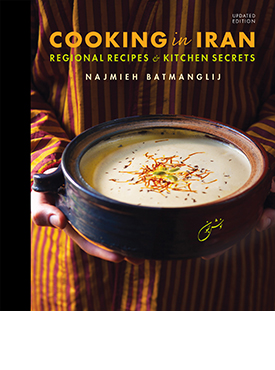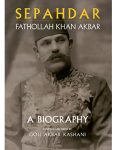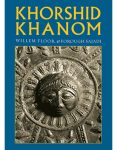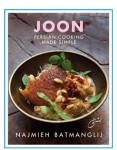About the Book
Najmieh Batmanglij was exiled from Iran 39 years ago. She was living in France where she did not speak the language or have proper documents—and above all, she was pregnant. Out of a nostalgia and yearning to connect with her roots, she wrote her first cookbook, Food of Life, as a kind of love letter to her children. She wanted to share with them all the good things she had experienced growing up in a traditional family in Iran.
Over the years, Food of Life has been called “the definitive book on Persian cooking” by the Los Angeles Times and “the Persian cookbook Bible” by Iranians and others. Food of Life was followed by six more cookbooks including Silk Road Cooking, which according to the New York Times, read like “a good novel—once you start it’s hard to put down.” But as she worked on these books at home in America, a fantastical dream took hold—a craving to revisit Iran and celebrate the specialties and traditional dishes of each region.
The challenges that faced her—emotional, political, and logistical—were daunting, but she felt she had to do it. She knew from her Silk Road research trip to China twenty years earlier that, under the bulldozer of modernity, Iran too would soon lose many of its traditional ways, special cooking techniques, and small artisanal workshops. Najmieh was determined to capture and preserve them before that happened.
After five years of overcoming obstacles, meticulous planning, and ten thousand miles of traveling the length and breadth of Iran—cooking with local cooks, visiting workshops, and developing recipes—Najmieh’s dream has been realized with the creation of Cooking in Iran: Regional Recipes and Kitchen Secrets. This book is a distillation of those past five years. It is an authoritative exploration of a cuisine whose cultural roots are among the deepest of any in the world.
Najmieh takes us with her on an extraordinary culinary journey: from the daily fish market in Bushehr, on the Persian Gulf, where she and her host buy and cook a 14-pound grouper in a tamarind, cilantro, and garlic sauce, to the heart of historical Isfahan, in central Iran, where she prepares lamb necks in a yogurt, saffron, and candied orange peel sauce topped with caramelized barberries. Traveling north to the Caspian Sea, she introduces us to the authentic Gilaki version of slow-cooked duck in a pomegranate and walnut sauce, served over smoked rice; and the unique flavors of a duck-egg omelet with smoked eggplant and baby garlic. Lingering in the north, in tribal Kurdistan, she treats us to lamb-and-bulgur meatballs filled with caramelized onions and raisins in a saffron sauce. Dropping south, to Bandar Abbas on the coast, she teases our palate with rice cooked in date juice and served with spicy fish, while in Baluchistan she cooks spiced goat in a pit overnight and celebrates the age-old method of making bread in hot ashes.
At every village and off-the-beaten-track community, Najmieh unearths traditional recipes and makes surprising new discoveries, giving us a glimpse along the way of the places where many of the ingredients for the recipes are grown. She treks through the fields and orchards of Iran, showing us saffron being picked in Khorasan and pomegranates in Yazd, dates harvested by the Persian Gulf, pistachios in Kerman, and tea and rice by the Caspian.
With more than 250 recipes and 400 photographs, Cooking in Iran is packed with inspiring ideas and practical tips—everything you’ll need for recreating these glorious dishes so that you can embark on a culinary journey of your own.
Reviews
From the Washington Post, 11/06/18:
Najmieh Batmanglij is the grande dame of Iranian cooking. It’s time you knew her name
“Cooking in Iran: Regional Recipes & Kitchen Secrets,” out now from Mage Publishers, is the culmination of tens of thousands of miles of travel through Iran she conducted in three stints each year since 2015. She gathered 250 recipes, mostly from women, along the way.”
———-
From the New York Times,10/02/2018:
Najmieh Batmanglij has written eight cookbooks about the cooking of Iran (and its ancient predecessor, Persia), where she was born and lived until 1979. But “Cooking in Iran” (Mage, $65), her magisterial new book, is the first for which she was able to return and travel freely around the country with notebook and camera. The result is an engrossing visual feast of modern Iran, its food and its people, from fish markets in the north piled with fresh Caspian salmon; through farmlands planted with pomegranates, pistachios and crocuses for saffron; to the Indian spices of the Persian Gulf region. With 400 accessible recipes, plus culinary history, ethnography and deep dives on ingredients like smoked rice and barberries, “Cooking In Iran” is an essential new book. JULIA MOSKIN
From American Library Association, Booklist, 10/04/2018:
This immense volume, full of lush photographs of cities, restaurants, landscapes, and beautifully prepared
food, offers a culinary tour of Iran. Divided into chapters according to region, the book’s sections offer not
only recipes but also histories of cooking styles, ingredient preferences, and food cultures. Batmanglij was
born in Iran but has lived much of her adult life in France and the U.S., and she writes a travel diary
alongside her recipes, bringing to her subject deep familiarity as well as rekindled wonder. Many of the
dishes (barley and tahini soup, sweet gingerbread crackers) may not be familiar to the average American
reader, and some of the recipes include instructions (“Dig a round pit”) impossible for the average home
cook. But this book is not about how to make unfussy and quick meals. Rather, it is a study of a nation’s
food, a reference text preserving ingredients, techniques, and traditions for future generations.
— Maggie Taft
———-
From Publishers Weekly,10/01/2018:
Batmanglij (Joon: Persian Cooking Made Simple), who grew up in Iran and has written extensively of the country’s cuisine, offers a massive and thorough guide to Persian cuisine. Batmanglij spent three years traversing the country, stopping in all of its regions, and in this collection of more than 250 recipes she shares an assortment of kebabs was well as osh, a traditional porridge-like soup made with butternut squash or carrot and bulgar. Highlights abound: Azerbaijani dumpling soup, featuring dumplings stuffed with ground meat in a spicy tomato broth; saffroned almond and pistachio baklava; walnut and sumac meatballs (made with lamb or turkey thigh); a savory mushroom pie, similar to the Russian pirozhki; and pistachio cake. Batmanglij fills the book with photos of vendors, farmers, and ancient ruins, and offers history lessons and bits of trivia (“The oldest archeological evidence of pistachios was found in Jarmo”). Stories of intimate family dinners shared on her journey and recipes she discovered talking with the locals—such as sweet and sour patties with chicken, mint, and turmeric, and almond paste with saffron (a friend’s mother would “spread the almonds on a clean sheet and cover them with pussy willow flowers”)—lend the feel of flipping through a scrapbook with a friend. This is a terrific, reverential, and accessible cookbook. (Nov.)
———-
From The Boston Globe, 10/08/2018:
Regional food from every corner of Iran celebrated in a new cookbook
Most Persian food is a cuisine that began in the royal courts and found its way into homes whose kitchens were staffed with cooks. A dish could require hours of prepping and several more of cooking, and then grand platters of jeweled rice, kebabs, and intricate pastries appeared. Those are all represented in Cooking in Iran: Regional Recipes & Kitchen Secrets, by Najmieh Batmanglij. But so are ordinary meals that those cooks might have made for their own families, like wheat porridge with lamb and chickpeas, a popular breakfast dish, or osh, a soup of yogurt and chickpeas, sometimes with meatballs, sold at food stands across Iran. Osh is also made with lentils and herbs, barley and fresh stinging nettles, dried fruits and noodles, split peas and bulgur, lamb neck and beans. Batmanglij, who teaches cooking and lives in Washington, D.C, left her homeland almost four decades ago. For this book, she traveled 10,000 miles inside Iran to cities and tiny villages, from the Caspian Sea in the north, to regions bordering Iraq on the west, Afghanistan on the east, the Persian Gulf in the south. We see the author in a baseball cap tied with a gauzy scarf, pictured throughout. This is Batmanglij’s eighth book (her husband is her publisher). It’s mammoth, the size of an encyclopedia volume, divided into geographic areas, with maps, and begins in Tehran, her home city, where she brings roses to her parents’ burial site. She traveled with a driver and photographer, who shot ordinary people cooking in their environment and working — picking tea leaves (tea became popular during the Russian occupation of Northern Iran in the early 19th century), saffron, pistachios, and more. She offers historical sketches of each region, along with explanations of dishes sometimes found in neighboring countries, like the small deep-fried pies called pirashki (a variation of Russian pirozhki), and nan, and biryani (adaptations are made in India). We see a food bazaar in Iranian Azarbaijan with intricate pointed brick archways, metal platters piled high with pointed, identical mounds of colorful foods that seem painted rather than placed by hand, and a cafe where older men are smoking hookahs across from their younger counterparts looking at their cellphones. The author writes about Iranian Jews, who, she says, “have been so intertwined with Persian culture for so long that little difference is seen in their food — except perhaps that, to be kosher, butter is not mixed with meat.” Iranian Kurds in the west, along the Zagros Mountains, prepare appealing rustic dishes, stuffing large onions with rice and herbs, simmering white beans with heaps of chives, and adding barberries to lamb stew, bulgur and lamb meatballs, and rice with mushrooms. Iranian Armenians, writes Batmanglij, were pioneers in the arts. In the Persian Gulf, the various cultures Replay within Iran — Persians, Arabs, Baluchis, Kurds, East Africans, Armenians, and Jews live together and have intermarried over the centuries, she says. You’ll find grilled whole fish, fish-head soup, date buns, flatbreads baked on ashes (and the many other flatbreads in the cuisine), rice with lamb and rose petals, minced lamb kebabs, dried balls of a yogurt-like mixture called kashk, date halva, rice in every way, including in the national favorite, chelow, steamed saffron rice with a golden “tah-dig” crust. I made chelow with tah-dig for the first time and though the dish had too much olive oil (the grains might have better absorbed the alternate fat ghee), the rice and its crust were spectacular. I also cooked eggs in pureed eggplant, a dish from the Caspian region, charring the eggplants directly on a gas burner, which turned this striking dish mildly smoky. You will learn about Iran and its people here, and you’ll be stunned by their food. To read the book is to be immersed in another culture, region by region. It took Batmanglij five years to accomplish it all and every bit of labor shows. – Sheryl Julian
——–
What to Give: Books About Food, Books about Persian cooking
The new cookbook from Najmieh Batmanglij, on the other hand, exemplifies the joy to be found in tradition. I’ve been a fan of Ms. Batmanglij’s Persian cookbooks for almost 30 years. Lovely as they were, though, they were written while she was an exile in the U.S. But in 2015 Ms. Batmanglij was able to return to Iran and, over the next three years, she traveled tens of thousands of miles throughout the country searching out unique local dishes. The result is the encyclopedic “Cooking inIran: Regional Recipes and Kitchen Secrets”(Mage, 726 pages, $65). While some of the book’s more than 250 recipes require very hard-to-find ingredients, many require at most a spice or two that may not yet be in your pantry, and all will reward your effort with deep, intense flavors. But recipes are only part of the experience. The essays on cultural history, tales of personal encounters and 450 photos provide as deep an understanding of this ancient, intriguing and wonderfully diverse country as you are likely to find anywhere. To me, this is what the ideal food gift book should be—beautiful, extravagant in every way, thought-provoking and delicious. – John “Doc” Willoughby
———
From Saveur, 11/05/2018
SEVEN DEEP-DIVE COOKBOOKS WE’RE DIGGING INTO THIS FALL
I got goosebumps just reading the introductory paragraphs and stories accompanying the variety of regions of Najmieh Batmanglij’s home country, Iran. Exiled for 39 years, her first journey back was to create this anthology of Iranian cooking. Her book is littered with passionate snippets dedicated to cities within Iran, along with stories of her family and long-lost friends. It comes with a silk ribbon to help you keep your place in this 700 page tome. I found myself bookmarking every other page, drawn to dishes such as the aromatic rice, lamb, rose petals and barberries, or the tangy dish of tomato and lime broth with tiny meatballs. The journey Batmanglij took to research and write this book is truly astounding; my Persian pantry has grown tenfold with her guidance, exuberance, and recipes. – RACHEL DOLFI
———————————-
Cooking in Iran: Evan Kleiman’s Cookbook of the year, 02/08/19 (KCRW radio, Los Angeles):
Sometimes the best book of the year is the last one we receive.
In 2018, that book for me was Najmieh Batmanlij‘s “Cooking in Iran: Regional Recipes & Kitchen Secrets.” It’s a stunning regional tour of the country that is at once a celebration of the return of an exile and an investigation of dishes previously unknown to the author.
If you already own “Food of Life,” the book Batmanglij published in 1986, then you have what is considered to be the bible of Persian classics: written by a cook of discerning palate, determined to communicate the traditional way of doing things in a gorgeously presented way. The cookbook allowed me to be fluent in communicating with my Persian boyfriend’s family in the ’80s. At least at the table. All of us thought this was extraordinary—magical, even…
———-
“Najmieh is the goddess of Iranian cooking”
—Yotam Ottolenghi, The Guardian
“Chefs Across the country are at the forefront of Najmieh’s fan base. They know what’s good, and they are Inspired by the ingredients and techniques she brings to the table.“
—Bonnie S. Benwick, The Washington Post
Contents
A Geography of Iran 11
Preface 13
Tehran 14
Arrival 17
Climate 18
A Little History 21
The Tajrish Bazaar 25
Downtown Tehran 33
Iranian Soups and the Kitchen 37
Ladies’ Lunch 40
Tehran in the 1900s 42
Darband 50
Darakeh 56
THE CASPIAN 68
A Little History 71
A Caspian Story 73
Cooking in Rasht 80
Masouleh 103
Harvesting Tea 166
AZARBAIJAN 172
A Little History 175
Ardabil 177
Tabriz 178
Cooking in Tabriz 183
The Story of Omaj 193
The National Dish:
Chelow Kabab 208
The Story of Minced Kabab 215
Wine in an Ancient Kitchen 227
QOM 228
A Little History 229
QAZVIN 232
A Little History 233
Dessert 241
HAMADAN 244
A Little History 245
Iranian Jews 253
ARAK 268
A Little History 269
BREAD 284
A Flat Bread Story 287
KURDISTAN AND THE TRIBAL REGION 312
A Little History 313
ISFAHAN 352
A Little History 354
Iranian Armenians 379
KASHAN 382
A Little History 383
Do Not Despair 385
KHORASAN 388
A Little History 391
Saffron 393
Barberries 417
YAZD 428
A Little History 431
The Cypress at Abarkuh 435
Iranian Zoroastrians 437
Pomegranates 443
A Pastry Workshop 452
KERMAN 461
A Little History 463
The Pistachio Journey 465
The Persian Garden 509
FARS / SHIRAZ 516
A Little History 518
Hafez 520
Sesame 555
Fill the Glass with Wine 559
KHUZESTAN 563
A Little History 565
THE PERSIAN GULF 574
A Little History 577
Bushehr 579
The Bounty of the Sea 581
The Date Palm 585
A Conversation Between a Date Palm and a Goat 593
SISTAN AND BALUCHISTAN 680
A Little History 682
A Visual Glossary of an Iranian Pantry 702
Acknowledgements 704
Credits 706
RECIPE CONTENTS 708
Index 714
About the Author
NAJMIEH BATMANGLIJ, hailed as “the guru of Persian cuisine” by The Washington Post, has spent the past 30 years cooking, traveling, and adapting authentic Persian recipes to tastes and techniques in the West. The 25th Anniversary Edition of her book Food of Life: Ancient Persian and Modern Iranian Cooking and Ceremonies was called “This summer’s most coveted tome” by Vogue. Her Silk Road Cooking: A Vegetarian Journey was selected as “One of the 10 best vegetarian cookbooks of the year” by the New York Times; and her From Persia to Napa: Wine at the Persian Table won the Gourmand Cookbook Award for the world’s best wine history book of 2007. Happy Nowruz: Cooking with Children to Celebrate the Persian New Year is a guide to customs thousands of years old yet as vital as ever – enjoyable for families no matter where they live or what their beliefs. She is a member of Les Dames d’Escoffier and lives in Washington, DC, where she teaches Persian and Silk Road cooking, and consults with restaurants around the world. Her most recent book is Joon: Persian Cooking Made Simple. Her web site is www.najmieh.com.
[/tabber]








